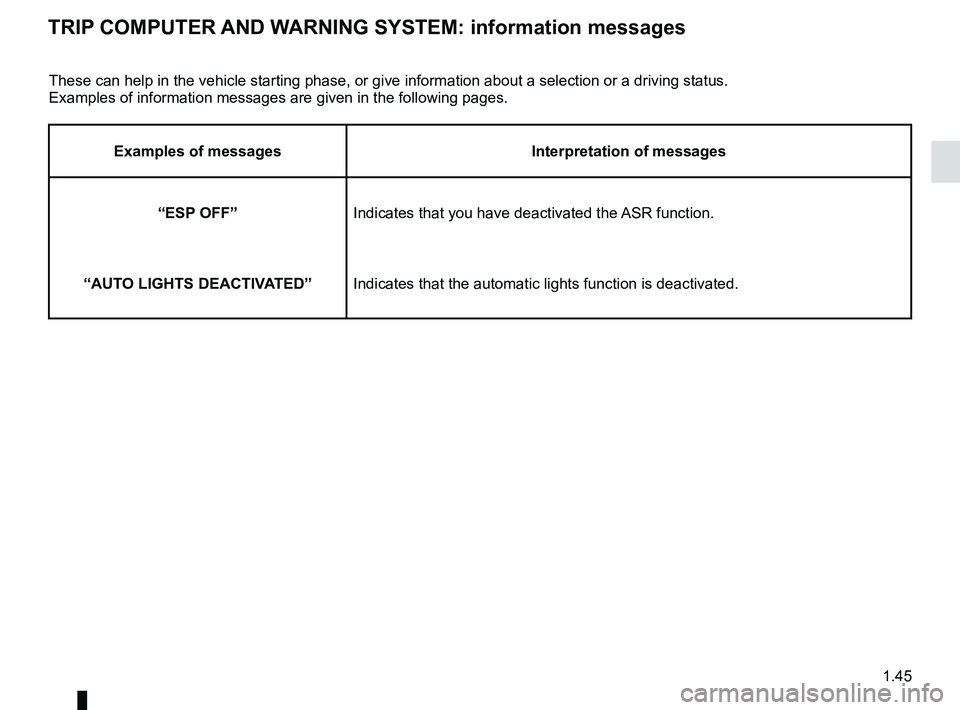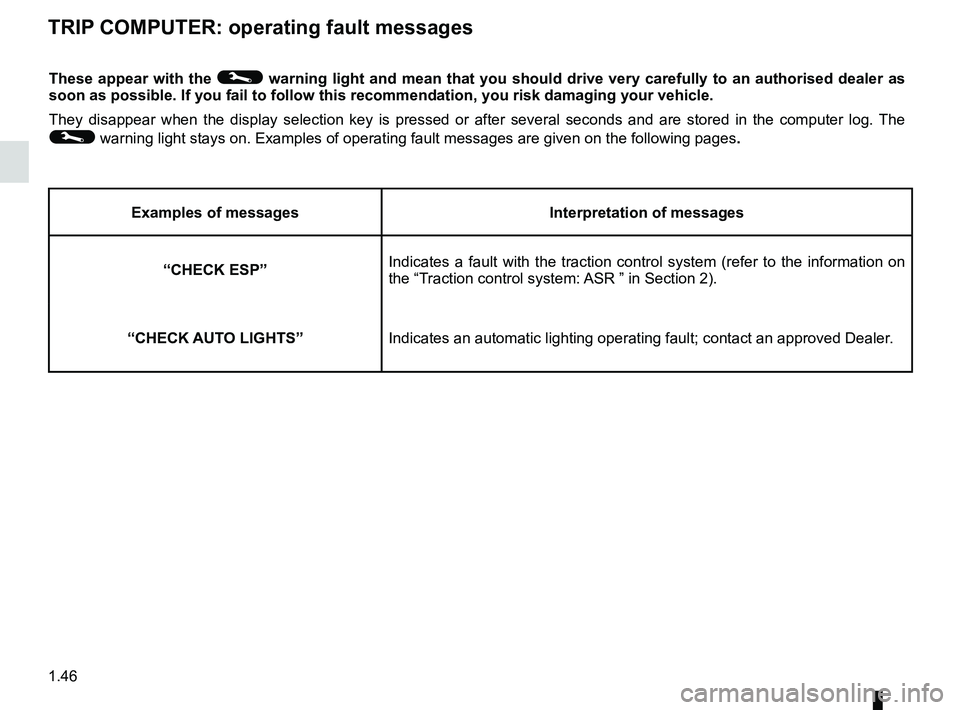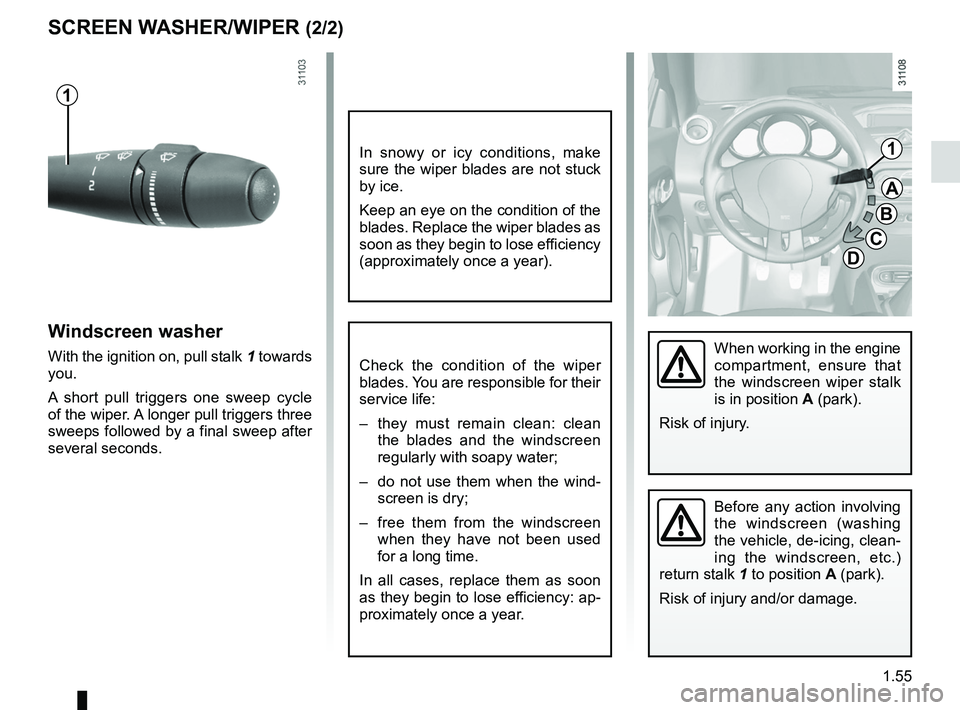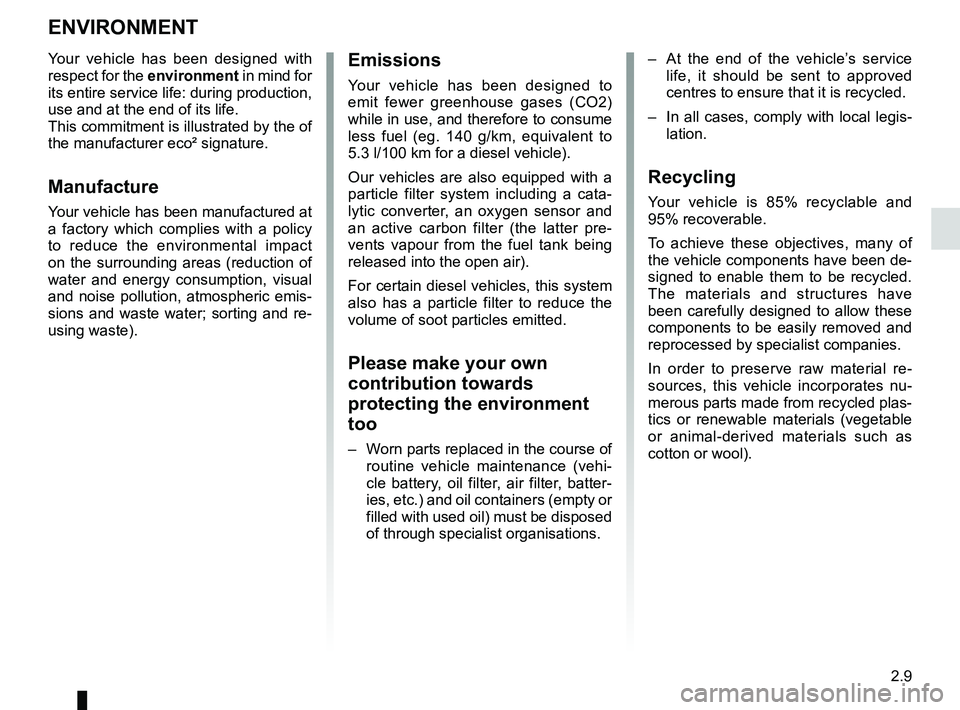2012 RENAULT WIND ROADSTER ESP
[x] Cancel search: ESPPage 43 of 185

JauneNoirNoir texte
1.37
ENG_UD20502_3
Tableau de bord : témoins lumineux (E33 - X33 - Renault)
ENG_NU_865-6_E33_Renault_1
The presence and operation of the warning lights DEpEND ON THE EQUIpMENT AND COUNTRY.
W ARNING LIGHTS (4/4)
\bElectronic Stability program
(ES p) and traction control
(ASR) indicator light.
There are several reasons why the light
may come on: refer to the information
on the “Electronic stability program:
ESP” and “traction control system:
ASR” in Section 2.
™Seat belt reminder light
If the driver’s seat belt is not
fastened the light remains lit when
the vehicle is started, then when the
car reaches a speed of approximately
6 mph (10 km/h), it flashes and a beep
sounds for approximately 2 minutes.
Central display 1
™ seat belt reminder light.
¹ passenger air bag deactivation
warning light.
1
Page 51 of 185

1.45
ENG_UD24361_1
Ordinateur de bord : messages d’information (E33 - X33 - Renault)
ENG_NU_865-6_E33_Renault_1
TRIp COMpUTER AND WARNING SYSTEM: information messages
These can help in the vehicle starting phase, or give information about a selection or a driving status.
Examples of information messages are given in the following pages.
Examples of messages Interpretation of messages
“ESp OFF” Indicates that you have deactivated the ASR function.
“AUTO LIGHTS DEACTIVATED” Indicates that the automatic lights function is deactivated.
Page 52 of 185

1.46
ENG_UD24362_1
Ordinateur de bord : messages d’anomalies de fonctionnement (E33 - X33 - Renault)
ENG_NU_865-6_E33_Renault_1
TRIp COMpUTER: operating fault messages
These appear with the © warning light and mean that you should drive very carefully to an authorised dealer as
soon as possible. If you fail to follow this recommendation, you risk damaging your vehicle.
They disappear when the display selection key is pressed or after several seconds and are stored in the computer log. The
© warning light stays on. Examples of operating fault messages are given on the following pages .
Examples of messages Interpretation of messages
“CHECK ESp” Indicates a fault with the traction control system (refer to the information on
the “Traction control system: ASR ” in Section 2).
“CHECK AUTO LIGHTS ”Indicates an automatic lighting operating fault; contact an approved Dealer .
Page 59 of 185

lights:main beam headlights ...................................... (current page)
warning buzzer ...................................................... (current page)
see-me-home lighting ............................................ (current page)
lights mobile directional ............................................. (current page)
JauneNoirNoir texte
1.53
ENG_UD21753_2
Éclairages et signalisations extérieurs (E33 - X33 - Renault)
ENG_NU_865-6_E33_Renault_1
Turning off the fog lights
Turn ring 3 again until mark 4 is oppo -
site the symbol for the fog light that you
wish to switch off. The corresponding
indicator light on the instrument panel
goes out.
The front and rear fog lights switch off
when the exterior lights are switched
off.
Special case
The front and rear fog lights do not op-
erate in automatic mode.
They only come on when the end of
ring 4 is in position
u or k.
EXTERIOR LIGHTING AND SIGNALS (2/2)
gFront fog lights
Turn centre ring 3 on stalk A
until the symbol faces mark 4, then re-
lease it.
Operation of the fog lights depends on
the exterior lighting position selected,
and an indicator light will light up on the
instrument panel.
Before driving at night:
check that the electrical
equipment is in good con -
dition. As a general precau -
tion, check that the lights are not
obscured (by dirt, mud, snow or ob-
jects which could cover them).
1A3
4
fRear fog lights
Turn centre ring 3 on stalk A
until the symbol faces mark 4, then re-
lease it.
Operation of the fog lights depends on
the exterior lighting selected, and an in-
dicator light will light up on the instru -
ment panel.
To avoid inconveniencing other road
users, remember to switch off the rear
fog light when it is no longer needed.
When driving in fog or snow, or
when transporting objects which are
higher than the roof, the headlights
do not come on automatically.
Switching on the fog lights remains
the responsibility of the driver: the
indicator lights on the instrument
panel inform you whether the fog
lights are lit (indicator light on) or not
(indicator light not on).
Page 61 of 185

JauneNoirNoir texte
1.55
ENG_UD25520_2
Essuie-vitre / lave-vitre avant (E33 - X33 - Renault)
ENG_NU_865-6_E33_Renault_1
Before any action involving
the windscreen (washing
the vehicle, de-icing, clean -
ing the windscreen, etc.)
return stalk 1 to position A (park).
Risk of injury and/or damage.
SCREEN WASHER/WIpER (2/2)
When working in the engine
compartment, ensure that
the windscreen wiper stalk
is in position A (park).
Risk of injury.Windscreen washer
With the ignition on, pull stalk 1 towards
you.
A short pull triggers one sweep cycle
of the wiper. A longer pull triggers three
sweeps followed by a final sweep after
several seconds.
A
B
C
D
1
Check the condition of the wiper
blades. You are responsible for their
service life:
– they must remain clean: clean
the blades and the windscreen
regularly with soapy water;
– do not use them when the wind-
screen is dry;
– free them from the windscreen
when they have not been used
for a long time.
In all cases, replace them as soon
as they begin to lose efficiency: ap-
proximately once a year.
In snowy or icy conditions, make
sure the wiper blades are not stuck
by ice.
Keep an eye on the condition of the
blades. Replace the wiper blades as
soon as they begin to lose efficiency
(approximately once a year).
1
Page 67 of 185

starting the engine ................................ (up to the end of the DU)
starting the engine ................................ (up to the end of the DU)
2.3
ENG_UD29995_3
Démarrage / Arrêt moteur avec carte RENAULT mains libres (E33 - X33 - Renault)
ENG_NU_865-6_E33_Renault_2
Starting, stopping the engine
St ARtING/StoPPING thE ENGINE
Starting the engine
Engine warm or cold:
– Turn the ignition key to “Start” posi-
tion D without accelerating;
– release the key as soon as the
engine starts.
Special note: if starting the engine
when the outdoor temperature is very
low (below - 10 ° C): hold down the
clutch pedal until the engine starts.
Stopping the engine
With the engine idling, turn the key
back to “Stop” position St.
Driver’s responsibility
Never leave your vehicle
with the key or remote con-
trol inside the vehicle and
never leave a child (or a pet) unsu-
pervised, even for a short while.
There is a risk that they could start
the engine or operate electrical
equipment (electric windows etc.)
and trap part of their body (neck,
arms, hands, etc.).
Risk of serious injury.
Never switch off the ignition
before the vehicle has stopped
completely . Once the engine has
stopped, the brake servo, pow -
erassisted steering, etc., and the
passive safety devices such as
air bags and pretensioners will no
longer operate.
The steering is locked when the key
is removed.
Page 70 of 185

fueladvice on fuel economy .................. (up to the end of the DU)
practical advice ..................................... (up to the end of the DU)
fuel economy ........................................ (up to the end of the DU)
filter air filter ............................................................. (current page)
filter diesel filter ........................................................ (current page)
driving ................................................... (up to the end of the DU)
maintenance .......................................................... (current page)
antipollution advice ............................................. (up to the end of the DU)
2.6
ENG_UD20551_2
CONSEILS : antipollution, économies de carburant, conduite (E33 - X3\
3 - Renault)
ENG_NU_865-6_E33_Renault_2
Jaune NoirNoir texte
Advice on antipollution and fuel economy
ADVIcE: antipollution, fuel economy and driving (1/3)
By virtue of its design, moderate fuel
consumption and initial settings, your
vehicle conforms to current antipol-
lution regulations. The manufacturer
is actively striving to reduce pollutant
exhaust gas emissions and to save
energy. But the fuel consumption of
your vehicle and the level of pollutant
exhaust gas emissions are also your
responsibility. Ensure that it is main -
tained and used correctly.Maintenance
It is important to remember that failure to
respect antipollution regulations could
lead to legal action being taken against
the vehicle owner. In addition, replacing
engine, fuel supply system and exhaust
components with parts other than those
originally recommended by the manu -
facturer may alter your vehicle so that
it no longer complies with antipollution
regulations.
Have your vehicle adjusted and
checked by an approved Dealer, in ac-
cordance with the instructions given in
your maintenance schedule: they will
have all the equipment necessary for
ensuring that your vehicle is maintained
to its original standard.
Engine adjustments
– ignition: this does not require ad -
justment.
– spark plugs: for optimum fuel econ-
omy, efficiency and performance
the specifications laid down by our
Design Department must be strictly
applied.
If the spark plugs have to be
changed, use the make, type and
gap specified for your vehicle’s
engine. Contact an approved dealer
for this.
– idle: this does not require adjust -
ment.
– air filter: a choked element will
reduce efficiency. It must be re -
placed.
Page 73 of 185

environment .......................................... (up to the end of the DU)
2.9
ENG_UD25716_1
Environnement (sans marque) (X44 - X45 - X77 - X81 - X85 - X90 - X91 \
- X83 - X61 - TEST - X95 - J95 - R95 - F90 Ph2 - X33 - X47 - X43 - X38 - H79 - X62 - X32 -\
X09 -
ENG_NU_865-6_E33_Renault_2
Environment
ENVIRoNMENt
Emissions
Your vehicle has been designed to
emit fewer greenhouse gases (CO2)
while in use, and therefore to consume
less fuel (eg. 140 g/km, equivalent to
5.3 l/100 km for a diesel vehicle).
Our vehicles are also equipped with a
particle filter system including a cata -
lytic converter, an oxygen sensor and
an active carbon filter (the latter pre -
vents vapour from the fuel tank being
released into the open air).
For certain diesel vehicles, this system
also has a particle filter to reduce the
volume of soot particles emitted.
Please make your own
contribution towards
protecting the environment
too
– Worn parts replaced in the course of
routine vehicle maintenance (vehi -
cle battery, oil filter, air filter, batter -
ies, etc.) and oil containers (empty or
filled with used oil) must be disposed
of through specialist organisations. –
At the end of the vehicle’s service
life, it should be sent to approved
centres to ensure that it is recycled.
– In all cases, comply with local legis -
lation.
Recycling
Your vehicle is 85% recyclable and
95% recoverable.
To achieve these objectives, many of
the vehicle components have been de-
signed to enable them to be recycled.
The materials and structures have
been carefully designed to allow these
components to be easily removed and
reprocessed by specialist companies.
In order to preserve raw material re -
sources, this vehicle incorporates nu -
merous parts made from recycled plas-
tics or renewable materials (vegetable
or animal-derived materials such as
cotton or wool).
Your vehicle has been designed with
respect for the
environment in mind for
its entire service life: during production,
use and at the end of its life.
This commitment is illustrated by the of
the manufacturer eco² signature.Manufacture
Your vehicle has been manufactured at
a factory which complies with a policy
to reduce the environmental impact
on the surrounding areas (reduction of
water and energy consumption, visual
and noise pollution, atmospheric emis-
sions and waste water; sorting and re-
using waste).